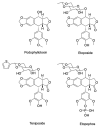Using Micropropagation to Develop Medicinal Plants into Crops
- PMID: 33800970
- PMCID: PMC8003982
- DOI: 10.3390/molecules26061752
Using Micropropagation to Develop Medicinal Plants into Crops
Abstract
Medicinal plants are still the major source of therapies for several illnesses and only part of the herbal products originates from cultivated biomass. Wild harvests represent the major supply for therapies, and such practices threaten species diversity as well as the quality and safety of the final products. This work intends to show the relevance of developing medicinal plants into crops and the use of micropropagation as technique to mass produce high-demand biomass, thus solving the supply issues of therapeutic natural substances. Herein, the review includes examples of in vitro procedures and their role in the crop development of pharmaceuticals, phytomedicinals, and functional foods. Additionally, it describes the production of high-yielding genotypes, uniform clones from highly heterozygous plants, and the identification of elite phenotypes using bioassays as a selection tool. Finally, we explore the significance of micropropagation techniques for the following: a) pharmaceutical crops for production of small therapeutic molecules (STM), b) phytomedicinal crops for production of standardized therapeutic natural products, and c) the micropropagation of plants for the production of large therapeutic molecules (LTM) including fructooligosaccharides classified as prebiotic and functional food crops.
Keywords: in vitro propagation; medicinal crops; medicinal plants; phytomedicines.
Conflict of interest statement
The authors declare no conflict of interest.
Figures
References
-
- Hussain A., Ahmed I., Nazir H., Ullah I. Plant Tissue Culture: Current Status and Opportunities. In: Leva A., Rinaldi L.M.R.L., editors. Recent Advances in Plant in vitro Culture. InTech; London, UK: 2012. pp. 1–28. - DOI
-
- Sedaghati B., Haddad R., Bandehpour M. Efficient plant regeneration and Agrobacterium-mediated transformation via somatic embryogenesis in purslane (Portulaca oleracea L.): An important medicinal plant. Plant Cell Tissue Organ Cult. 2019;136:231–245. doi: 10.1007/s11240-018-1509-3. - DOI
-
- Mohan N., Nikdad S., Singh G. Studies on seed germination and embryo culture of Jatropha curcas L. under in vitro conditions. Biotech. Bioinf. Bioenergy. 2011;1:187–194.
Publication types
MeSH terms
LinkOut - more resources
Full Text Sources
Other Literature Sources



